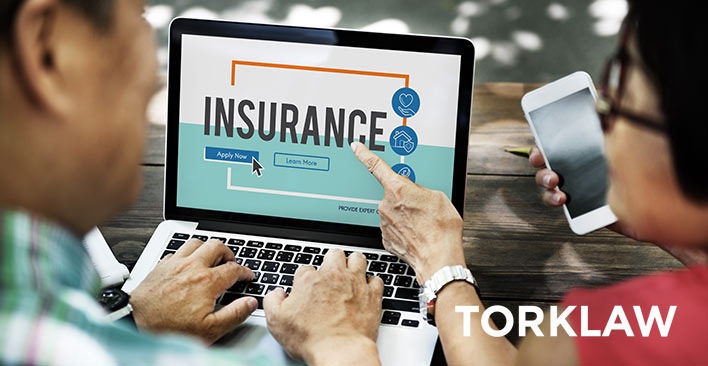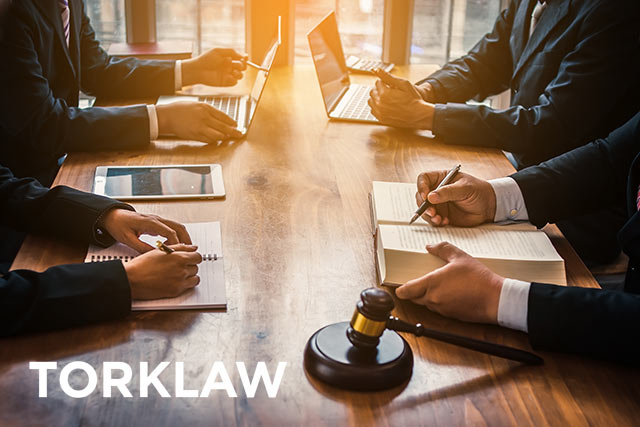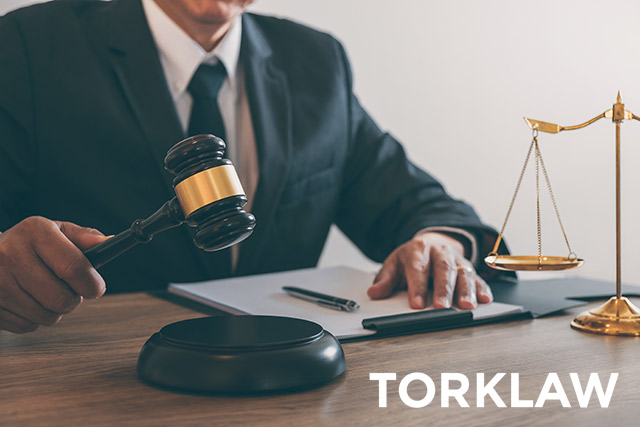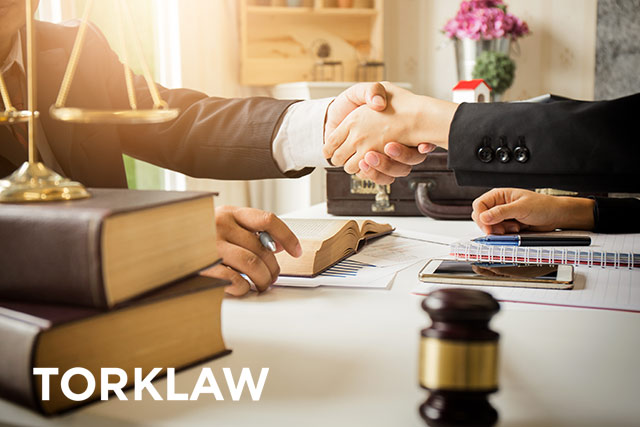If you have been injured in an accident, you may be considering the services of a personal injury attorney but are not quite sure what to expect. Below, we outline the steps of personal injury case; how it proceeds through the insurance and legal systems, and how working with a law firm like TORKLAW can help you maximize your recovery and get your life back on track.
The Accident and Aftermath
Being injured is a traumatic experience, and it’s a challenge to remember what to do at that moment and the time that immediately follows. Ideally, you will take a few key actions that will help you protect yourself and your right to compensation, such as gathering evidence, seeking medical treatment or advice, keeping good records, and staying away from social media.
One of the smartest things you can do is to consult with a lawyer about protecting your best interests. Insurance companies know that most consumers are inexperienced with the law and use that to their advantage. Insurance adjusters often dissuade customers from retaining personal injury lawyers by telling them that attorney fees will take too much out of their settlement. A 1999 study by the Insurance Research Council found that accident victims who hire attorneys typically recover more money than they would on their own, even after lawyers’ fees are factored in.
What a Personal Injury Attorney Will Do
Too often, the person responsible for your injury or your loved one’s death does not have the insurance coverage to pay for your losses in full, or even in part. A good personal injury attorney will examine every aspect of your case to determine if there are additional options to recover damages. For instance, other parties may be liable, such as the at-fault person’s employer, if they were working, or a product manufacturer, if a defective product was involved. These types of third-party claims can be complicated for a layperson, but an experienced personal injury lawyer will know exactly what to do.
Perhaps most importantly, the lawyer will put the other party’s insurance company on notice that he or she is representing you, informing them that they should deal with the law office on all aspects of the case, and not contact you. Being free from dealing with the other party will allow you to focus on your own recovery and well-being.
Dealing with the Insurance Company
After an accident, dealing with the at-fault party’s insurance company can be a prolonged process that includes filing a claim, negotiating a settlement, and deciding whether to accept what the other party offers, or go to trial.
Filing a Claim
Immediately after the accident, the injured party must file a claim with the insurance company representing the at-fault party. In a car accident, people usually exchange this information. In a premises liability case, a product liability case, or another type of accident, it may not be this easy to determine where to file your claim.
In addition, for your claim to be successful, you must submit supporting evidence of your injury, as well as proof that the other party’s action, or failure to act, was the proximate cause of your injury. You must determine the amount of your claim: that is, how much money you will need in order to return to the state of health and well-being you were in before the accident. This may include past, current and future medical bills, past, current and future lost wages, compensation for pain and suffering, and many other factors. As part of your claim for damages, you must also write a compelling, well-documented demand letter to explain why you are owed that amount.
Your lawyer can handle all those tasks for you, including determining a fair and reasonable settlement amount, as well as sending a demand to inform the insurance company that they must either settle for the requested amount, or be prepared to go to trial if they do not provide an acceptable counteroffer.

Negotiating a Settlement
The insurance company will respond by either accepting your demand or issuing a counter offer, if they haven’t already reached out with an offer. Many times, insurance companies offer what initially looks like a reasonable amount, but when you begin to add up your existing and potential future losses, you may discover that the offer only covers a fraction of what you will need to be made whole. You are within your rights to refuse any and all offers that don’t meet your needs — your right — for a full recovery.
Your attorney will handle the grueling process to reach a settlement. Be patient – most personal injury attorneys are skilled negotiators, and most personal injury cases are settled to everyone’s satisfaction without a trial.
At some point, the insurance company will make a final settlement offer. If the offer is too low, you and your lawyer will decide whether to go to trial. There is always a risk involved in this decision: the jury may side with you, or they may award far less than you asked for — or decide against you altogether. Your attorney will advise you regarding the best course, whether filing a personal injury lawsuit or accepting the defendant’s final offer.
The Civil Court Experience
Once you decide to litigate, a substantial portion of the process will take place “behind the scenes,” and it may seem like nothing is happening. But rest assured that your attorney, case manager, and office staff are busy building a solid case: filing motions, interviewing witnesses, dealing with accident and injury experts, and taking all the necessary steps of a personal injury lawsuit.
Filing a Complaint
To take your personal injury case from a claim to a lawsuit, your attorney will file a complaint with the court against the person or entity who caused your injury or the death of your loved one. Your complaint will outline the details of your case, the amount of compensation you seek, and the documentation to support your claim.
In most states, the defendant must answer your complaint within 30 days. There are several ways this could go:
- Typically, the defense will respond by stating what portions of the complaint they agree to (if any), what they contest, and any defense they have.
- If they don’t respond in time, the court may find against the defense in a default judgment.
- The answer may contain a counterclaim or a claim against a third-party complaint. Those claims must then be answered within a certain time.
- In some cases, the parties may resolve the case through mediation or arbitration, either voluntarily or by requirement.
- The defense may file a “demurrer,” which states that your complaint doesn’t prove any obligation for them to pay anything. In that case, there must be a hearing on the complaint before going to trial.
- One or both parties may try to have part of the case dismissed by motion, for instance, if both parties agree to certain facts.The case can even be dismissed entirely, for example, if the defense can show that the lawsuit cannot possibly win.
If the parties do not reach an agreement, or if the matter is not disposed of by motion, the case will go to trial.
Discovery
The next step is the “discovery” phase, during which each side provides the other with documents and information about the case, including depositions and written questions for witnesses to answer under oath. In addition, your attorney will speak with forensic experts, and request and analyze medical records and files to strengthen your case. The defense lawyer may request that you undergo an Independent Medical Evaluation (IME) by a doctor specified by the defense.
Deposition
In a deposition, a lawyer for the other side will question witnesses, usually in the attorney’s office, with a court reporter present. When you give a deposition, you will be sworn in as you would be in court. You won’t be alone; your attorney will be with you. Also, your attorney will work with you beforehand to prepare you for what to expect.

Jury Selection and Trial
In personal injury cases, usually either side can choose to have the trial before a judge or in front of a jury. If a jury trial is selected by either party, the next step is to choose twelve jurors. In most courtrooms, the judge will lead the plaintiff and defense attorneys through a vetting process of potential jurors to find those who are acceptable to both parties.
Opening Statements
Following jury selection, the judge will usually give the jury some general instructions, after which, the plaintiff’s attorney will give his or her “opening statement” about the facts that will be presented about the plaintiff’s case during the trial.
Then, the lawyer for the defense may make his or her opening statement, or choose to wait until after the plaintiff’s attorney has rested his or her case.
Case in Chief
Next, the plaintiff’s attorney presents the “case in chief.” In a criminal court, the defendant’s guilt must be proved “beyond a reasonable doubt.” In a civil case, the plaintiff’s burden of proof is only to show that the defendant is liable to a “preponderance of the evidence,” or is more likely than not, to be at fault.
The first testimony in a personal injury trial is usually from the plaintiff, who is asked about the accident, what caused it, and how it has impacted his or her life. The plaintiff’s lawyer will use this testimony to validate the victim’s economic damages, the pain and suffering caused by the injury, and demonstrate a major difference in the victim’s quality of life. The plaintiff’s lawyer will also call those who witnessed the incident to testify about what they saw and heard, and to present any facts or evidence that affect the case.
Expert Testimony
The plaintiff’s attorney may hire an expert accident reconstructionist to establish fault. Medical providers may testify regarding the plaintiff’s injuries and future medical needs, such as further treatment or permanent disabilities. A forensic accountant may testify about lost wages or other financial damages. The victim’s employer may testify about promotions and salary increases the victim may have received were it not for the injury. After the witnesses have been questioned by the plaintiff’s lawyer, the defendant’s lawyer has the right to cross-examine each one.
 Defense
DefenseAfter the plaintiff’s lawyer rests his/her case, the defense lawyer presents their case. The defense may attempt to place the blame for the accident on the plaintiff, and bring in its own experts to refute the plaintiff’s experts or minimize their claims.
When the defense counsel rests, the plaintiff’s lawyer has the right to rebuttal; that is, to disprove the defense’s case.
Jury Deliberations
Once there are no further rebuttals, the judge instructs the jury and they retreat to the jury deliberation room, where they select a foreperson and begin the process of deciding the case.
While criminal cases require a unanimous verdict, civil courts only require nine jurors out of the twelve to rule the defendant liable. If this happens, they must then determine the amount of money the plaintiff should receive.
If the jury decides for the plaintiff, but for less than the amount requested, there aren’t many options for recourse, unless some grave error or misconduct can be proven. This is, however, a difficult charge to prove. If the jury decides for the defense, your attorney will talk to you about the possibility of appealing the case – that is, taking it to a higher court.
If you do win the case, the award, or the money the defendant must pay, will be sent to your attorney or law firm. They will collect their fee, pay off any liens that may exist on your settlement (from medical providers or finance companies to repay cash advances received during the trial), and send the remaining amount to you.
Personal injury law can be complicated. It pays to hire a knowledgeable, experienced law firm to manage your personal injury lawsuit, step by step. Contact TorkLaw today for a free consultation. We work on a contingency basis, so you don’t pay unless we win. Call us today: we have offices in Southern California, Northern California, Illinois, New York and Texas, and are on hand to answer all your questions.





